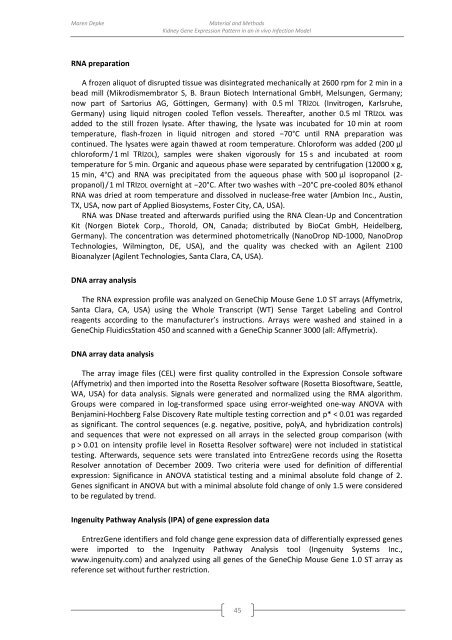genomewide characterization of host-pathogen interactions by ...
genomewide characterization of host-pathogen interactions by ...
genomewide characterization of host-pathogen interactions by ...
You also want an ePaper? Increase the reach of your titles
YUMPU automatically turns print PDFs into web optimized ePapers that Google loves.
Maren Depke<br />
Material and Methods<br />
Kidney Gene Expression Pattern in an in vivo Infection Model<br />
RNA preparation<br />
A frozen aliquot <strong>of</strong> disrupted tissue was disintegrated mechanically at 2600 rpm for 2 min in a<br />
bead mill (Mikrodismembrator S, B. Braun Biotech International GmbH, Melsungen, Germany;<br />
now part <strong>of</strong> Sartorius AG, Göttingen, Germany) with 0.5 ml TRIZOL (Invitrogen, Karlsruhe,<br />
Germany) using liquid nitrogen cooled Teflon vessels. Thereafter, another 0.5 ml TRIZOL was<br />
added to the still frozen lysate. After thawing, the lysate was incubated for 10 min at room<br />
temperature, flash-frozen in liquid nitrogen and stored −70°C until RNA preparation was<br />
continued. The lysates were again thawed at room temperature. Chlor<strong>of</strong>orm was added (200 µl<br />
chlor<strong>of</strong>orm / 1 ml TRIZOL), samples were shaken vigorously for 15 s and incubated at room<br />
temperature for 5 min. Organic and aqueous phase were separated <strong>by</strong> centrifugation (12000 x g,<br />
15 min, 4°C) and RNA was precipitated from the aqueous phase with 500 µl isopropanol (2-<br />
propanol) / 1 ml TRIZOL overnight at −20°C. After two washes with −20°C pre-cooled 80 % ethanol<br />
RNA was dried at room temperature and dissolved in nuclease-free water (Ambion Inc., Austin,<br />
TX, USA, now part <strong>of</strong> Applied Biosystems, Foster City, CA, USA).<br />
RNA was DNase treated and afterwards purified using the RNA Clean-Up and Concentration<br />
Kit (Norgen Biotek Corp., Thorold, ON, Canada; distributed <strong>by</strong> BioCat GmbH, Heidelberg,<br />
Germany). The concentration was determined photometrically (NanoDrop ND-1000, NanoDrop<br />
Technologies, Wilmington, DE, USA), and the quality was checked with an Agilent 2100<br />
Bioanalyzer (Agilent Technologies, Santa Clara, CA, USA).<br />
DNA array analysis<br />
The RNA expression pr<strong>of</strong>ile was analyzed on GeneChip Mouse Gene 1.0 ST arrays (Affymetrix,<br />
Santa Clara, CA, USA) using the Whole Transcript (WT) Sense Target Labeling and Control<br />
reagents according to the manufacturer’s instructions. Arrays were washed and stained in a<br />
GeneChip FluidicsStation 450 and scanned with a GeneChip Scanner 3000 (all: Affymetrix).<br />
DNA array data analysis<br />
The array image files (CEL) were first quality controlled in the Expression Console s<strong>of</strong>tware<br />
(Affymetrix) and then imported into the Rosetta Resolver s<strong>of</strong>tware (Rosetta Bios<strong>of</strong>tware, Seattle,<br />
WA, USA) for data analysis. Signals were generated and normalized using the RMA algorithm.<br />
Groups were compared in log-transformed space using error-weighted one-way ANOVA with<br />
Benjamini-Hochberg False Discovery Rate multiple testing correction and p* < 0.01 was regarded<br />
as significant. The control sequences (e. g. negative, positive, polyA, and hybridization controls)<br />
and sequences that were not expressed on all arrays in the selected group comparison (with<br />
p > 0.01 on intensity pr<strong>of</strong>ile level in Rosetta Resolver s<strong>of</strong>tware) were not included in statistical<br />
testing. Afterwards, sequence sets were translated into EntrezGene records using the Rosetta<br />
Resolver annotation <strong>of</strong> December 2009. Two criteria were used for definition <strong>of</strong> differential<br />
expression: Significance in ANOVA statistical testing and a minimal absolute fold change <strong>of</strong> 2.<br />
Genes significant in ANOVA but with a minimal absolute fold change <strong>of</strong> only 1.5 were considered<br />
to be regulated <strong>by</strong> trend.<br />
Ingenuity Pathway Analysis (IPA) <strong>of</strong> gene expression data<br />
EntrezGene identifiers and fold change gene expression data <strong>of</strong> differentially expressed genes<br />
were imported to the Ingenuity Pathway Analysis tool (Ingenuity Systems Inc.,<br />
www.ingenuity.com) and analyzed using all genes <strong>of</strong> the GeneChip Mouse Gene 1.0 ST array as<br />
reference set without further restriction.<br />
45

















